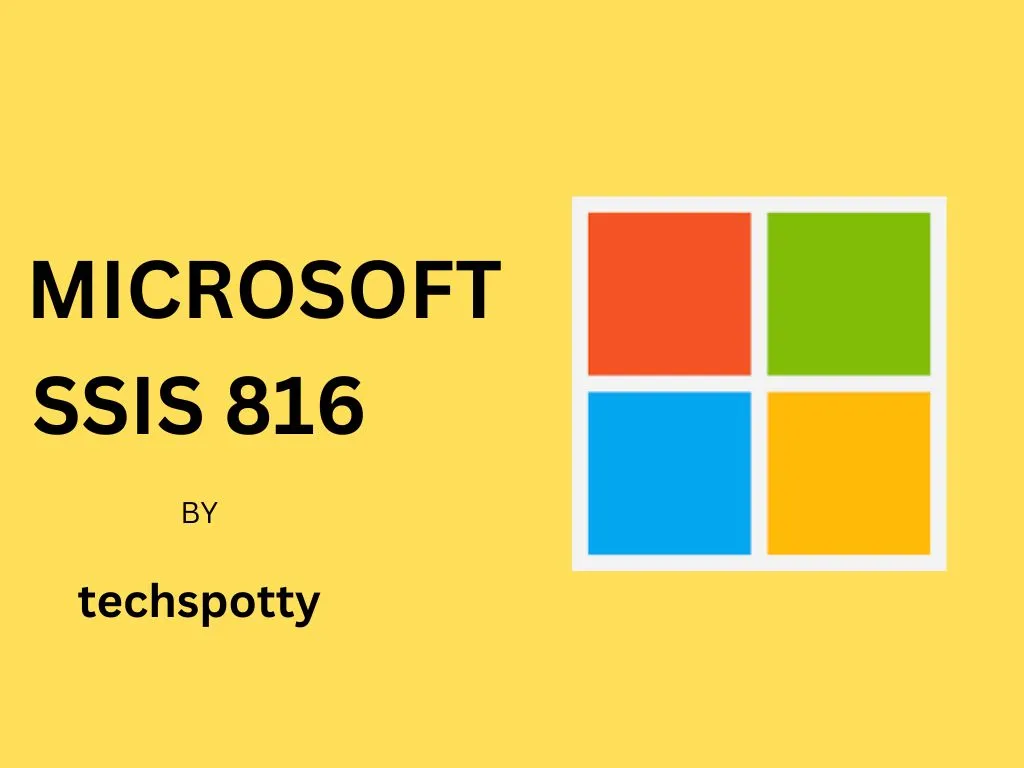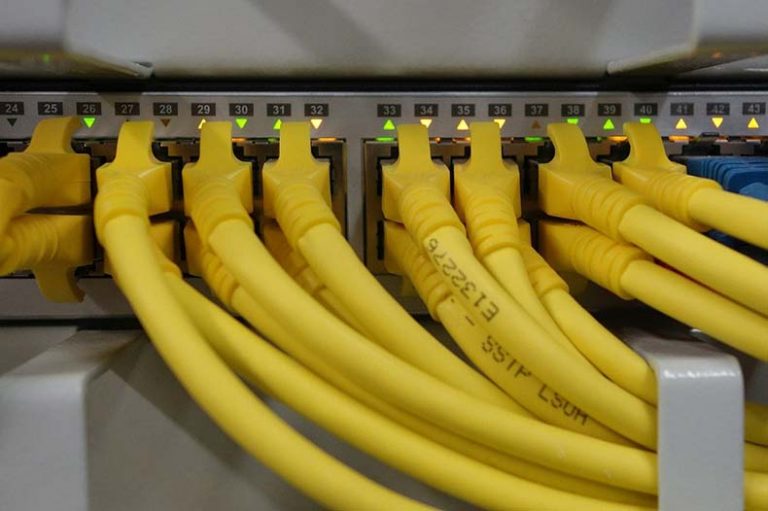SSIS 816 Guide – Acknowledge Data Integration With SSIS-816
Today’s modern world calls for modern tools and techniques to utilize and store data effectively. For this purpose, Microsoft designed an incredible tool SSIS 816 to streamline your data integration process and revolutionize your data transformation approach. The powerful capabilities can take your data management journey to the next level. So, let’s dive into the exploration of the limitless potential of Microsoft SSIS-816.
What is Microsoft SSIS 816?

SSIS, or SQL Server Integration Services, is a reliable data integration and transformation tool developed by Microsoft. It plays a crucial role in making informed business decisions and is a preferred solution for ETL (Extract, Transform, Load) processes.
Both SSIS and 816 play crucial roles in the world of data integration, but understanding their distinct identities is key. Let’s break them down:
SSIS:
- Stands for: SQL Server Integration Services.
- What it is: A powerful toolkit developed by Microsoft specifically designed for data integration.
- What it does:
- Extracts data from various sources like databases, flat files, and web services.
- Transforms data by cleaning, manipulating, and applying business logic.
- Loads data into target destinations like databases, data warehouses, and reporting tools.
- Automates data movement between different systems, saving time and effort.
- Think of it as: The conductor of your data orchestra, seamlessly orchestrating the flow of information.
816:
- Refers to: A specific version or build number of the SSIS server integration services.
- What it signifies: An improvement or update over previous versions, potentially offering new features, bug fixes, or performance enhancements.
- Think of it as: A specific model of your data conductor, equipped with the latest upgrades for smoother data integration.
Key Points:
- SSIS is the overall platform, whereas 816 is a specific version with its own characteristics.
- 816 builds upon the foundation of SSIS, offering advancements in functionality and efficiency.
- When referring to data integration with Microsoft tools, you’ll often see them mentioned together as “SSIS 816”.
Remember: While 816 might be the latest and greatest, other versions of SSIS are still widely used and may be suitable depending on your specific needs and compatibility requirements.
I hope this clarifies the separate identities of SSIS and 816!
We will discuss the advancements SSIS 816 has brought into the tech world, its features, and its applications.
Core Components Of SSIS 816
In the realm of data integration, SSIS 816 stands as a robust tool, meticulously orchestrating and managing data flow between diverse sources and destinations. To truly understand its capabilities, let’s delve into its key components:
The Control Flow: Navigating Your Data Journey
Think of the control flow as your detailed itinerary for data movement. It defines the sequence of tasks, ensuring everything happens in the right order, much like planning your sightseeing stops on an adventure. This component includes:
- Sequence Containers: These act as stages in your itinerary, grouping related tasks and defining their execution order.
- Conditional Splits and Decision Points: Imagine encountering a fork in the road. These elements allow you to branch your data flow based on specific conditions, directing it down different paths depending on its content or status.
- Loops for Repetitive Tasks: Some data processing might require iterations. Loops empower you to execute tasks repeatedly until a specific condition is met, streamlining repetitive processes.
The Data Flow: Your Information Highway
This is where the magic happens! The data flow acts as the highway transporting your valuable information treasures (extracted from various sources) to their designated destinations. Here’s what makes it tick:
- Sources and Destinations: These act as entry and exit points for your data journey, connecting to diverse databases, flat files, or web services.
- Transformations: Imagine shaping your data for its destination. Transformation components clean, manipulate, and apply business logic to your data, ensuring it arrives in the desired format and structure.
- Data Converters: Think of these as language interpreters for your data. They translate data between different formats and encodings, enabling seamless communication between diverse systems.
Tasks: The Workhorses of Data Integration
These specialized workers perform specific actions within your data packages, handling various aspects of the integration process. Some key tasks include:
- File System Tasks: Interact with files and folders, performing operations like copying, moving, or deleting.
- Script Tasks: Allow you to execute custom code written in various languages like C# or VB.NET, offering immense flexibility for complex tasks.
- Send Mail Task: Notify users about task completion or errors through email notifications.
- Execute SQL Task: Interact directly with databases, executing SQL queries to retrieve, update, or delete data.
Packages: Bundling Everything Together
Imagine packing your essentials for your data expedition. Packages serve as neatly organized “backpacks” containing all the components (tasks, data flows) needed for a specific data integration mission. Each package has a clearly defined purpose, keeping things organized and efficient.
Remember: Understanding these core components empowers you to navigate the SSIS 816 landscape with confidence, building efficient and customized data integration solutions that meet your specific business needs.
Five Key Features of SSIS 816
Here are the top five features of Microsoft SSIS 816 that grab the attention of the majority of the audience.
Flexible integration
Microsoft SSIS 816 offers seamless integration with a diverse list of data sources, including both relational and non-relational databases, cloud-based platforms, traditional databases, and other storage platforms. This streamlined process ensures effortless data accessibility, empowering you to utilize data for maximum effectiveness.
ETL Process
Microsoft SSIS-816 ensures that you enjoy a comprehensive and efficient mechanism for extracting, transforming, and loading data. It allows swift data extraction from various sources with an easy connectivity process, versatile data transformation tools including robust error handling, automates data loading, employs parallel processing for enhanced performance, incorporates security features, and much more.
Error Handling

Microsoft SSIS 816 offers enhanced error handling and debugging facilities. It ensures the accuracy and reliability of the data integration process. In case of errors, it captures and logs the error along with the checkpoints where the error occurred. This feature helps troubleshoot the actual cause of the error.
Security
Security is one of the key features demanded by every individual who participates in today’s online world. Security in data integration is crucial for ensuring the reliability, compliance, and overall health of organizations’ data infrastructure.
For this purpose, Microsoft SSIS 816 provides encryption and secure connections. Also, consists of logging and auditing features.
Simple administrative workflow
Microsoft SSIS-816 offers a simplified administrative workflow by providing a user-friendly interface for deploying, designing, and managing ETL processes. Administration can easily monitor, schedule, and maintain SSIS packages and their execution from a single centralized workplace.
Installing and Setting Up SSIS 816
Are you ready to conquer the world of data integration with the powerful tool known as SSIS 816? While the specific steps may vary slightly depending on your environment, understanding the general installation and setup process will ensure a smooth start to your data management journey.
Prepping Your Toolkit:
Before embarking on this adventure, make sure you have the essential tools in your arsenal. This includes the appropriate operating system (refer to Microsoft documentation for specific compatible versions), a compatible .NET Framework (usually 4.6 or later), and most importantly, Microsoft SQL Server Integration Services. If you already have SQL Server installed, SSIS 816 might be bundled with it – just remember to enable or configure it during the setup.
Choosing Your Installation Path:
When it comes to installation, you have two main options:
- Going Solo: If you only need SSIS functionality and don’t have SQL Server, download the individual SSIS 816 installer from the Microsoft Download Center. Then, follow the on-screen instructions, selecting the desired features and components suited to your needs.
- Teaming Up with SQL Server: If you’re already part of the SQL Server family, SSIS 816 usually comes along for the ride during the SQL Server installation process. Just make sure to select the “Integration Services” feature during setup. This option is ideal if you’re building a complete data management ecosystem with SQL Server.
Gearing Up and Getting Started:
Once you’ve successfully installed SSIS 816, you’ll need some tools to help you get started:
- SQL Server Management Studio (SSMS): This is your command center for creating, managing, and executing SSIS packages. Connect to your SQL Server instance within SSMS and access the Integration Services section to unleash your data management power.
- Visual Studio (Optional): While not necessary for basic tasks, Visual Studio offers a more advanced development environment for building and debugging complex SSIS packages. Consider this if you need elaborate data transformations or custom scripting.
- Documentation and Resources: Don’t underestimate the power of online resources! Leverage the vast amount of available documentation, tutorials, and community forums to become an SSIS 816 expert. These resources will provide valuable insights into features, best practices, and troubleshooting tips.
Applications and Use Cases of SSIS 816
Here are some of the most common real-world applications and use cases of Microsoft SSIS 816.
Retail Sales and Customer Analytics
Microsoft SSIS-816 is a tool designed to integrate data from multiple retail stores. With this tool, you can keep track of the inventory in stores, online, and in warehouses, all in one place. Instant integrations make it easy to keep a record of customer purchase patterns, optimize pricing strategies, and make informed decisions about marketing campaigns.
Educational Institution Data Integration
Microsoft SSIS 816 plays an important role in managing and integrating data at the educational level. It helps keep records of student profiles, fee structures, course enrollments, faculty details, and much more.
Healthcare Data Integration
Healthcare organizations comprising hospitals, laboratories, and pharmacies can make effective use of Microsoft SSIS 816 to integrate data. They can integrate data from patient records, inventory details, lab results, patient information, and staff information. Medical professionals should have access to patient records at all times to ensure improved patient care and better compliance with regulatory requirements.
Financial Data Integration
Financial organizations take the most benefit from Microsoft SSIS 816. They can use the software to avoid human error, prevent security risks, and keep records of transactions, customer accounts, regulatory records, market feeds, and much more. Extracting, transforming, and using this data allows real-time financial analysis regulatory reporting, and risk management.
These real-time examples show how SSIS 86 can be used in various industries and demonstrate the effectiveness of automating data integration processes. In this way, organizations can make informed decisions based on timely and accurate information.
Benefits of SSIS 816
Here are some of the benefits of using Microsoft SSIS-816 in your organization for data extraction, transformations, and loading.
Unprecedented Speed and Efficiency
SSIS 816 redefines data processing speed through its powerful features:
Parallel Processing: Imagine multiple workers tackling complex tasks simultaneously. This is precisely what parallel processing enables, significantly accelerating data movement and analysis, especially for large datasets. No more waiting idly while your data processes chug along.
Dynamic Scaling: Need more muscle for demanding tasks? SSIS 816 automatically scales its resource allocation, preventing bottlenecks and ensuring smooth performance, no matter the workload. Your data integration processes adapt to your needs seamlessly.
Streamlined Data Flow Design: Intuitive design tools empower you to craft optimized data pipelines, further enhancing the overall efficiency of your data integration processes. Say goodbye to clunky and inefficient data flows.
Data Quality and Security: Your Top Priorities
With SSIS 816, data quality and security become integral parts of your integration strategy:
Advanced Data Cleansing: Ensure the accuracy and reliability of your information with built-in features for comprehensive data cleaning and validation. Eliminate inconsistencies and build trust in your data for reliable analysis and decision-making. No more basing your decisions on inaccurate or unreliable information.
Robust Security Measures: Protect your sensitive data with robust security features like granular access control and encryption. Detailed data lineage and auditing further boost security by providing clear records of data flow, simplifying troubleshooting and compliance checks. Keep your data safe and secure with peace of mind.
Flexibility and Versatility: Adapting to Your Needs
SSIS 816 isn’t a one-size-fits-all solution. It adapts to your unique requirements:
Rich Task Library: Connect to diverse data sources, formats, and transformations with a vast array of tasks at your disposal. Design data integration solutions that perfectly address your specific needs and workflows. No more struggling to fit into a rigid toolset.
Customizable Packages: Craft tailored data integration packages that seamlessly align with your business processes and objectives. Get the perfect fit for any data integration challenge. Unleash the power of customization to meet your specific needs.
Seamless Connectivity: Connect seamlessly to both cloud-based and on-premises data sources, ensuring smooth data movement across diverse environments regardless of their location. Break down data silos and connect your information effortlessly.
Additional Benefits: Enhancing the User Experience
SSIS 816 goes beyond core functionalities, offering additional advantages:
User-Friendly Interface: Embrace the intuitive interface with visual design tools and improved documentation, making it accessible to both technical and non-technical users. Development and management become easier than ever. No more struggling with a complex and unfriendly interface.
Reduced Development Costs: Reuse components and packages, promoting efficiency and cost savings throughout your development process. Spend less time and money building and maintaining your data integration solutions.
Active Community and Support: Never feel alone on your data integration journey. A vibrant community and readily available support resources offer valuable expertise and guidance whenever you need them. Get help and support whenever you encounter challenges.
Difference Between DTS and SSIS
Both DTS and SSIS are data integration tools developed by Microsoft, but they have some key differences:
DTS (Data Transformation Services):
- Released: 1999 as part of SQL Server 7.0
- Function: Primarily used for extracting, transforming, and loading (ETL) data between various sources and destinations.
- Features: Limited compared to SSIS, offered basic data manipulation and transformation capabilities.
- Pros: Simpler interface, easier to learn for basic tasks.
- Cons: Less powerful, limited functionality, no longer supported by Microsoft since 2013.
SSIS (SQL Server Integration Services):
- Released: 2005 as part of SQL Server 2005
- Function: Evolved from DTS, provides comprehensive data integration capabilities including ETL, data warehousing, data cleaning, and more.
- Features: Offers a wider range of tasks, components, and rich functionality for complex data manipulation and transformation.
- Pros: More powerful and versatile, actively supported by Microsoft, larger community and resources available.
- Cons: Steeper learning curve compared to DTS, may require more development resources for complex tasks.
Here’s a table summarizing the key differences:
| Feature | DTS | SSIS |
|---|---|---|
| Release Date | 1999 | 2005 |
| Functionality | Basic ETL | Comprehensive data integration |
| Features | Limited | Extensive |
| Learning Curve | Easier | Steeper |
| Support | Not supported | Actively supported |
| Community & Resources | Smaller | Larger |
Data Dangers Ahoy! Avoiding Common Mistakes with SSIS 816
Even the mightiest data explorers make mistakes sometimes. But fear not! This guide helps you steer clear of common issues and keep your data flowing smoothly with SSIS 816.
Uh Oh, Errors! How to Handle Them Like a Champ
Imagine forgetting your map on an adventure. Not good! The same goes for forgetting error handling in your SSIS packages. Here’s how to avoid it:
- Catch those Errors: Like a safety net, build error handling into your packages. This traps any problems so you can fix them quickly and keep your data journey moving.
- Test, Test, Test: Don’t just hope for the best, test your packages in different situations. This helps uncover hidden issues before they cause real trouble.
- Expect the Unexpected: Think about things that might go wrong, like internet problems or bad data. Plan for these in your error handling just in case.
Slow Down! Making Your Data Move Faster
Imagine carrying a huge backpack on your trip. It slows you down, right? The same goes for big data sets in SSIS. Make things faster with these tips:
- Simplify Your Steps: Look at your data transformations and tasks. Can you remove anything that makes things slow? Less is often more!
- Work in Batches: Instead of carrying everything at once, imagine breaking it into smaller loads. This helps your system handle big data sets without getting overwhelmed.
- Get Organized: If you’re using databases, use special tools to organize your data like a filing cabinet. This makes it easier and faster to find what you need.
Data Pirates Beware! Keeping Your Information Safe
Imagine leaving your treasure unguarded on your adventure. Yikes! Don’t let that happen to your data! Keep it safe with these tips:
- Secret Passwords: Use strong passwords for your data connections, especially for important stuff. Remember, strong passwords are like tough locks!
- Limited Access: Don’t give everyone the keys to your data kingdom. Only let people who need it in, just like you wouldn’t share your treasure map with everyone.
- Stay Updated: Keep your SSIS software and environment up-to-date, just like fixing any holes in your ship to keep bad guys out.
Remember, these are just some of the things to watch out for. By knowing what could go wrong and following these tips, you’ll be a data master, conquering any challenge and keeping your information safe with SSIS 816!
Final Words
In conclusion, I would say that Microsoft SSIS 816 has emerged as a powerful tool in the era of data integration. The versatile features it offers to show how its usefulness in different industries. As we explore more about the limitless possibilities of SSIS-816 we invite you for your positive feedback. How has your experience been with data integration tools? which data integration tools are you using and how have they affected our data management journey?
Moreover, share with us your thoughts about the Microsoft SSIS 816 tool, and join us for a great conversation.
Frequently Asked Questions
What does SSIS stand for in Microsoft?
SSIS stands for SQL Server Integration Services. It is a Microsoft tool built specifically to extract, transform, and load data in a fast and flexible way.
What is the difference between SSIS and SQL?
Microsoft SSIS is a tool for managing and designing the flow of data between different data sources. It is developed for efficient data ETL(Extraction, Transformation, Loading) processes. Whereas, SQL is a programming language for interacting with the database.
Does SSIS-816 require an SQL server to be installed?
SSIS-816 is a component of the SQL server and can be installed with or without an SQL server.
What port does SSIS 816 use?
It uses port 135 and this port cannot be changed.
Why is SSIS 816 important?
Microsoft SSIS 816 is an important data migration tool in today’s tech world. It allows you to complete many complex tasks such as data migration, loading, extraction, transformation, merging, aggregation, and much more with a few clicks.






